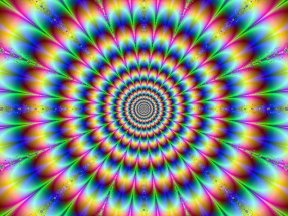
|
|
| The Future of Psychedelics 01 May 2008 - Common Ground |
|
The 2008 World Psychedelic Forum was an almost shockingly respectable affair. Held in Basel, Switzerland, in a spacious convention center next to the five-star Swissôtel Basel, the event drew 1,500 visitors for a two-day symposium on the past and present state of psychedelic thought and research. Despite flashes of eccentricity and DayGlo, you could have easily thought you were at a conference for alternative medicine or some abstruse but uncontroversial hobby. I felt honored to be one of the speakers, part of a high-profile group which included the Czech LSD researcher and theorist Stanislav Grof; Ralph Metzner, a well-known author and teacher and one of Leary’s original partners at Harvard; botanists Dennis McKenna, Christian Raetsch and Kat Harrison; MAPS director Rick Doblin; anthropologist and author Jeremy Narby; visionary artists Alex and Allyson Grey; and many more. The Gaia Media Foundation organized the forum, following upon their successful LSD conference, marking the 100th birthday of LSD chemist Albert Hofmann, two years ago. The 2008 event mingled nostalgia and insularity, futurism and hope, in equal measures. On the nostalgia side, Timothy Leary’s archivist Michael Horowitz mounted an exhibit of psychedelic art and media imagery, much of it from the heyday of late-sixties flower power, while Carolyn (Mountain Girl) Garcia gave a heartfelt speech about her journeys with the Merry Pranksters and the early Haight Ashbury days of the Grateful Dead. Although Hofmann is still alive, he declined to attend the festivities. A proper Swiss bourgeois, he didn’t approve of the conference being scheduled for Easter weekend. Sixty-five years since Hofmann’s first accidental dose, new frontiers in psychedelic research are opening up, represented at the Forum by an array of therapists and scientists from institutions across Europe, the U.S. and Canada. After a 35-year blockade on the subject, psychedelic research with human subjects is being permitted again. In Switzerland, a new study explores LSD as a tool of psychotherapy — the first such study to be allowed since the early 1970s. After years of persistent effort, the Multidisciplinary Association of Psychedelic Studies (maps.org) has succeeded in shepherding a number of projects through the regulatory system. Studies underway in the United States include research on use of psilocybin as a treatment for cluster headaches, and on MDMA (Ecstasy) as a treatment for Post-Traumatic Stress Disorder, a complex likely to haunt tens of thousands of veterans as they return from the Iraq War. Today, there is potential for psychedelics to be reintroduced into mainstream culture, not as drastic catalysts of social upheaval but as tools that can help people overcome serious problems. In the future, MAPS sees itself becoming a “nonprofit pharmaceutical company” that distributes psychedelics to qualified professionals. On a deeper, almost subconscious level, cultural and political resistance to the scrupulous study and use of psychedelics seems to have dissipated. A recent study conducted by John Hopkins, giving psilocybin to subjects who had never taken a psychedelic before, found that most subjects had long-lasting positive changes in their worldview. CNN and The Wall Street Journal gave prominent coverage to the results of this study. Beyond the scientific framework, there is compelling anecdotal data on the benefits of psychedelic use for creative processes, intellectual work and personal development. Recently, British newspapers reported that Francis Crick may have been taking low doses of LSD when he discovered the double helix shape of the DNA molecule (although he refused to allow this to be published before his death). The Nobel Prize winning biochemist Kary Mullis openly discussed the inspiration he gained from psychedelics. Many pioneers of the Internet and the personal computer experimented with psychedelics. And of course, the anthemic music, film, literature and visual culture of the late-1960s remains iconic. During his speech at the conference, Dr. Tom Roberts, a psychology professor at Northern Illinois University, proposed that the rediscovery of psychedelics in modern culture is creating a “second Reformation.” During the first Reformation, the Bible, which was only available to a priest class able to read Latin, was translated, printed and distributed to the masses, who were then able to read and interpret the “word of God” for themselves. By providing direct access to the mystical experience described in sacred texts from around the world, this “second Reformation” will, eventually, eliminate the need for a priest class that stands between the individual and personal revelation. Of course, such a deep shift in cultural perspective is a long process — the first Reformation developed over a few hundred years. At this point in time, those of us who see validity in the psychedelic experience can feel cautiously optimistic that we are reaching some tipping point in cultural perception. The discourse around hallucinogens has become far more sophisticated and measured than it was a generation ago. While Timothy Leary argued psychedelics were a shortcut to “enlightenment” and that everyone should “turn on” and “drop out,” researchers today consider psychedelics to be powerful tools that have negative effects if used improperly, like all tools. But these substances may also have tremendous benefits for the individual and society, when we become mature enough to make use of them. By Daniel Pinchbeck |
|
Related
Articles :
|
|
| Email
This Article To A Friend - Print
This Article Articles can be E-mailed to a friend and you can get a printable version of the article IMPORTANT: We provide all information for educational purposes only, and endorse or recommend nothing here. A special thanks to Keith for all his support and insight. |
|
